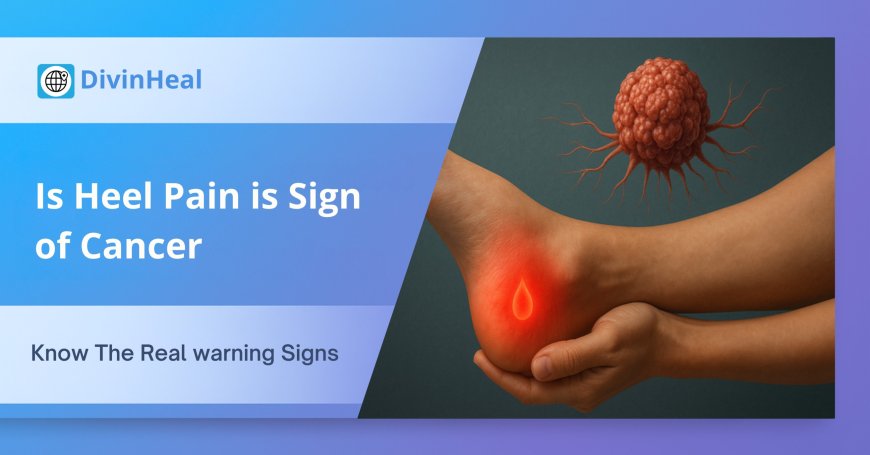Persistent Heel Pain: Could It Be Cancer? Key Warning Signs & What to Do

Heel pain is one of the most common foot complaints, affecting athletes, office workers, and seniors alike. Most cases stem from benign conditions—like plantar fasciitis, Achilles tendinitis, or heel spurs—and resolve with rest, stretching, and supportive footwear. However, in extremely rare situations, persistent heel pain can signal a more serious issue, including primary bone cancer or metastatic disease to the calcaneus (heel bone).
Common (Non-Cancerous) Causes of Heel Pain
Before worrying about malignancy, it’s important to recognize that over 99% of heel pain arises from mechanical or inflammatory conditions:
-
Plantar Fasciitis
Inflammation of the plantar fascia— a thick band of tissue under the foot. Sharp morning pain is classic, often improving with activity.
-
Heel Spurs
Bony calcium deposits that may press on surrounding soft tissues, causing localized soreness when walking.
-
Achilles Tendinitis
Overuse injury to the Achilles tendon insertion at the back of the heel, common in runners and athletes.
-
Bursitis
Inflammation of fluid-filled sacs (bursae) around the heel joint due to repetitive pressure or poorly fitting shoes.
-
Stress Fractures
Tiny cracks in the calcaneus from repetitive impact or sudden increases in activity. Presents with pinpoint pain on weight-bearing.
These conditions typically improve within six to eight weeks of conservative care—rest, ice, NSAIDs, stretching, orthotics, and physical therapy.
When to Suspect Cancer: Red-Flag Signs
Though exceedingly rare (<1% of cases), heel pain cancer warning signs warrant prompt medical attention:
-
Persistent Night Pain
Deep, constant pain that intensifies at night or when lying down—unlike mechanical pain, which eases with rest.
-
Unexplained Swelling or Lump
A visible mass or firm area on the heel, often accompanied by redness or increased warmth.
-
Systemic Symptoms
Unintended weight loss, fatigue, fever, or night sweats alongside heel pain suggest a systemic process like bone metastasis heel pain.
-
Rapid Worsening
Heel pain that escalates from mild to severe within days or weeks, hindering mobility and not responding to treatments.
-
History of Cancer
Patients with prior breast, lung, kidney, prostate, or thyroid cancers face higher risk of metastasis to distal bones, including the heel.
If you notice any of these red flags heel pain, seek evaluation without delay.
Primary vs. Metastatic Bone Cancer in the Heel
There are two main ways cancer affects the calcaneus:
-
Primary Bone Tumors
Rare in the heel; includes osteosarcoma, Ewing’s sarcoma, and chondrosarcoma. Typically seen in younger individuals (osteosarcoma in adolescents, chondrosarcoma in adults).
-
Metastatic Disease (Acrometastasis)
More common in older patients. Cancer cells from breast, lung, prostate, thyroid, or kidney travel through the bloodstream and implant in the heel bone—though this remains an unusual site for metastasis.
Both conditions can cause deep, aching calcaneal tumor symptoms, including severe pain, swelling, and potential bone destruction.
Diagnostic Approach for Suspicious Heel Pain
When malignancy is suspected, clinicians follow a structured pathway:
-
Clinical Examination
History of pain onset, duration, aggravating/relieving factors, and any systemic signs. Physical exam checks for lumps, range of motion, and neurovascular status.
-
Imaging Studies
-
X-Ray: First-line to detect bone lesions, lytic (destructive) or sclerotic (hardening) changes, and stress fractures.
-
MRI: Offers superior soft-tissue contrast, delineating marrow involvement and surrounding structures—crucial for identifying orthopedic oncology heel lesions.
-
CT Scan: Detailed assessment of bone architecture and guiding biopsy sites.
-
Bone Scan / PET-CT: Whole-body imaging to identify other metastatic sites.
-
Biopsy
A core-needle or open biopsy obtains tissue for histopathology, confirming cancer type and guiding treatment.
-
Laboratory Tests
Blood counts, inflammatory markers (ESR, CRP), alkaline phosphatase, calcium levels, and tumor markers (e.g., PSA) help support diagnosis.
Timely transition from symptom recognition to definitive diagnosis is key to improving outcomes.
Treatment Strategies for Cancer-Related Heel Pain
Management depends on cancer type, stage, and patient factors:
-
Surgical Resection
Limb-salvaging procedures (partial calcanectomy) remove the tumor while preserving foot function. In extensive cases, more radical surgery may be needed.
-
Radiation Therapy
External-beam radiation targets residual cancer cells, alleviates pain, and controls local disease.
-
Chemotherapy
Systemic drugs treat primary bone cancers (osteosarcoma, Ewing’s sarcoma) or metastatic disease, often combined with surgery and radiation.
-
Targeted & Immunotherapy
Personalized treatments based on tumor genetics, effective in certain metastatic cancers (e.g., breast, lung).
-
Palliative Care & Pain Management
Bisphosphonates, analgesics, and nerve blocks improve quality of life for advanced or inoperable cases.
Rehabilitation specialists and pain experts work alongside oncologists and orthopedic surgeons to ensure comprehensive care.
Distinguishing Benign vs. Malignant Heel Pain
|
Feature |
Benign Causes |
Cancer-Related Pain |
|
Pain Timing |
Worse with activity; better at rest |
Worse at night; constant |
|
Response to Treatment |
Improves with rest, NSAIDs, PT |
No relief from conventional care |
|
Visible Abnormalities |
Rare |
Lump, swelling, redness |
|
Systemic Signs |
Absent |
Weight loss, fatigue, fever |
|
Patient History |
Overuse, improper footwear |
Cancer history or high risk |
Prognosis & Follow-Up
-
Early Detection Enhances Survival: Localized bone cancers treated surgically have better outcomes and limb preservation rates.
-
Regular Surveillance: Follow-up imaging (X-ray, MRI, bone scans) detects recurrence or new metastases early.
-
Physical Rehabilitation: Tailored physiotherapy restores mobility and strength after surgery or radiation.
-
Patient Education: Understanding cancer warning heel pain empowers patients to seek timely care.
Ongoing collaboration between orthopedic oncologists, medical oncologists, radiologists, pathologists, and rehab therapists is vital for long-term success.


































